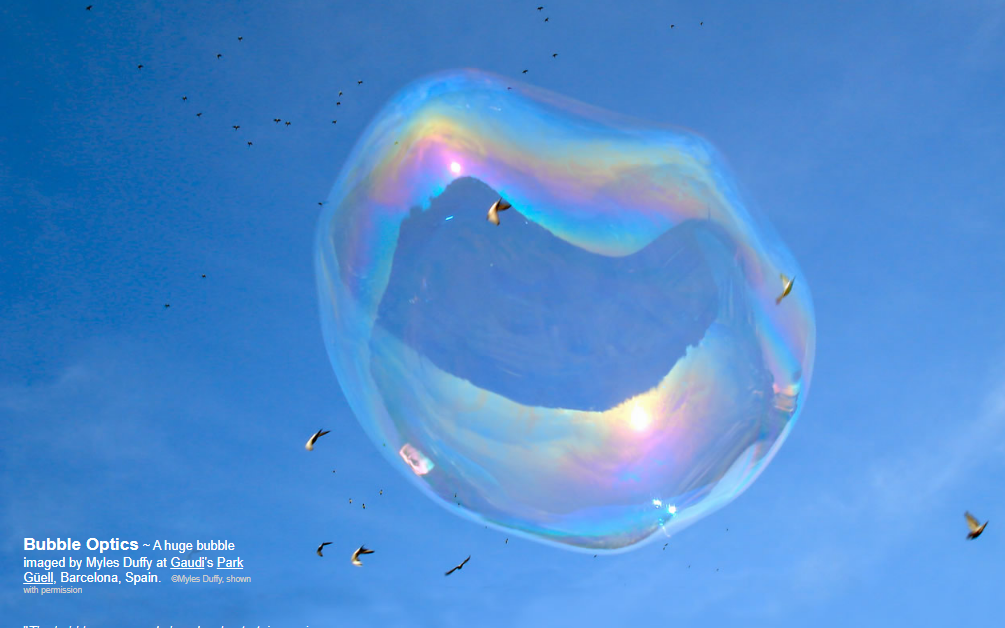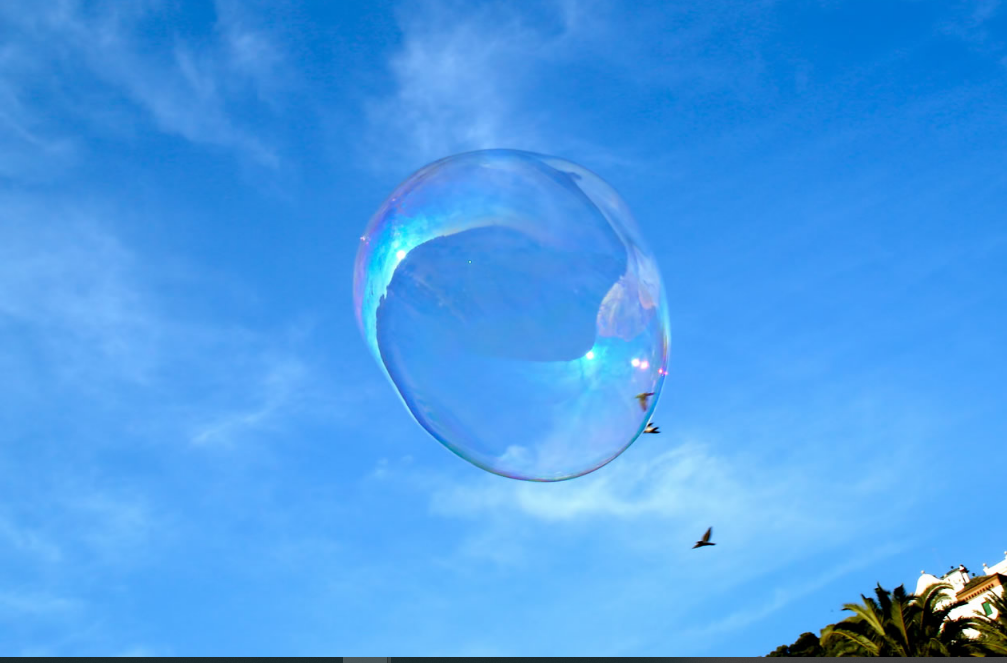OPOD - Bubble Optics
Bubble Optics: Unveiling the Intricate World of Soap Bubbles
Soap bubbles, seemingly simple and ephemeral, hold within them a mesmerizing display of optical phenomena. While they may appear as mere spheres of iridescence, a closer look reveals a tapestry of colors, reflections, and intriguing images. In this article, we will delve into the fascinating world of bubble optics, exploring the complex interplay of light and thin films that gives rise to their enchanting properties.
Reflections: A Mirror-Like Display
When observing a soap bubble, one can discern multiple reflections and images within its delicate walls. The lower section of the bubble presents an inverted image of the surroundings, created by the rear surface of the bubble acting as a large concave mirror. This image is real and would be visible on a screen if it could be held within the bubble.
Contrastingly, the upper part of the bubble showcases an upright image of the sun and landscape, thanks to the front surface of the bubble acting as a convex mirror. However, this image is virtual and cannot be captured on a screen. Moreover, fainter images of additional suns may also be glimpsed within the bubble.
Interference Colors: A Symphony of Hues
The vibrant colors that dance across the surface of a soap bubble cannot be fully explained by geometric optics alone. These iridescent hues are the result of thin-film interference, which arises due to the wave nature of light. Soap bubble films are incredibly thin, measuring only a few wavelengths of light across, making them perfect canvases for such colorful displays.
As light from the sky reaches the outer surface of the bubble, some is directly reflected while some enters the film and is subsequently reflected back by the inner surface. These two sets of outgoing waves overlap and interfere with each other. In certain directions and for specific colors (wavelengths), the crests of the waves align, resulting in bright colors. In other directions or colors, the waves may be out of phase and cancel each other out. This interplay of reflections and interference gives rise to the captivating patchwork of shifting and changing colors observed in soap bubbles.
Additional Interference from the Rear Surface
The rear surface of the soap bubble contributes a second set of interference colors to the overall display. As light interacts with both the front and rear surfaces of the bubble, multiple reflections and outgoing waves occur, following the same principles of interference as described earlier. This interplay between the front and rear surfaces adds depth and complexity to the tapestry of colors exhibited by soap bubbles.
The Wobbly Nature of Large Bubbles
Have you ever wondered why large bubbles appear wobbly and non-spherical? The answer lies in the intermolecular forces at play within the bubble's thin film. Water molecules possess an inherent attraction to one another, resulting in unbalanced intermolecular forces at the surface. This imbalance creates a tension-like effect, causing the surface to act as though it is stretched and under tension.
Small bubbles are able to maintain their spherical shape due to this surface tension force, which also slightly increases their internal air pressure. However, as bubbles grow larger, these forces become insufficient to maintain their sphericity. Consequently, large bubbles become more susceptible to distortion from air currents and exhibit a characteristic wobbly appearance.
Blow Your Own Bubbles
If you're inspired by the captivating world of bubble optics and wish to explore it further, why not try creating your own soap bubbles? By following simple recipes, you can embark on a journey of discovery, witnessing firsthand the intricate interplay of light and thin films that gives rise to the magical properties of soap bubbles.
In conclusion, soap bubbles are not just fleeting spheres of beauty; they are portals into a captivating realm of optical phenomena. From the intricate reflections and images within their delicate walls to the vibrant colors born from thin-film interference, each bubble holds a universe of visual wonders. So, the next time you encounter a soap bubble floating through the air, take a moment to appreciate the hidden complexities that lie within its shimmering surface.

Bubble Optics ~ A huge bubble imaged by Myles Duffy at Gaudi's Park Güell, Barcelona, Spain. ©Myles Duffy, shown with permission
"The bubbles were made by a local entertainer using one of those devices with a pole and fabric loop that produce very large bubbles. Each had a diameter of 1.5-3 feet. I was able to stand close and take photos before the kids burst them." Bubble recipes.
Look closely at the bubble. Optically, there is a lot going on. Complex iridescent colours produced by thin-film interference swirl over its surface. The micron thin bubble walls mirror the surroundings. The upper part of the bubble has an upright image of sun and dark landscape. The same scene is upside-down in the bubble's lower section. There are other, fainter, images showing at least two more suns.
Reflections:
The lower inverted image is from the bubble's rear surface acting as a large concave mirror. The image is real in that it would be visible on a screen if it could be held inside the bubble between its centre and back surface.
The upper upright image is from the bubble's front acting as a convex mirror. The reflected rays appear to come from an image of the sun and landscape placed between the bubble centre and its front surface. This image is virtual and cannot be captured on a screen.
Extra images originate from light reflected back and forth between the back and front surfaces. They are faint because of light loss at each reflection. Only the bright sun reveals their presence.
Interference colours:
Geometric optics explains the reflections. The colours can only be accounted for by invoking the wave nature of light. They are from thin-film interference, seen because soap bubble films are a mere few wavelengths of light across.
Imagine (lower right) skylight reaching the outer bubble surface. Some is directly reflected. Some enters the film and part of that is then reflected back by the inner film surface to leave the bubble in the same direction as the directly reflected waves.
The two outgoing wave trains overlap and interfere. In some directions - and for some colours (wavelengths) - the wave crests correspond. The waves are in-phase as shown at right. That particular direction and colour will be bright. In other directions or colours the two outgoing waves might be out of phase and cancel. There are actually multiple reflections and outgoing waves but the physics is the same.
The rear bubble surface contributes a second set of interference colours.
The overall result is a fascinating patchwork of iridescent colours shifting and changing as the soap film drains and thins by evaporation.
Why are large bubbles wobbly and non-spherical?
Water molecules attract one another. At a surface these intermolecular forces are unbalanced with the net effect that the surface acts as though it is stretched and under tension.
The minimum free energy condition is when the surface has the smallest area - a sphere. Small bubbles are held spherical by this surface tension force and it also slightly increases their internal air pressure.
The small forces and internal pressure are inadequate to maintain the sphericity of large bubbles. They wobble and are easily distorted in air currents.
Blow your own bubbles?
Recipes here.



Note: this article has been automatically converted from the old site and may not appear as intended. You can find the original article here.
Reference Atmospheric Optics
If you use any of the definitions, information, or data presented on Atmospheric Optics, please copy the link or reference below to properly credit us as the reference source. Thank you!
-
<a href="https://atoptics.co.uk/blog/opod-bubble-optics/">OPOD - Bubble Optics</a>
-
"OPOD - Bubble Optics". Atmospheric Optics. Accessed on November 12, 2024. https://atoptics.co.uk/blog/opod-bubble-optics/.
-
"OPOD - Bubble Optics". Atmospheric Optics, https://atoptics.co.uk/blog/opod-bubble-optics/. Accessed 12 November, 2024
-
OPOD - Bubble Optics. Atmospheric Optics. Retrieved from https://atoptics.co.uk/blog/opod-bubble-optics/.